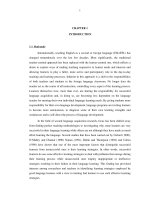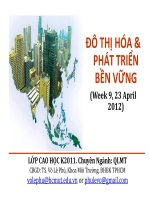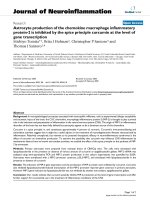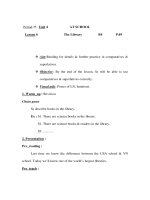week 01 week 09 date of preparing period 25 unit five things i do lesson 01 a my day a1 2 i objectives by the end of the lesson students will be able to describe their daily activities ii la
Bạn đang xem bản rút gọn của tài liệu. Xem và tải ngay bản đầy đủ của tài liệu tại đây (94.17 KB, 14 trang )
<span class='text_page_counter'>(1)</span><div class='page_container' data-page=1>
<b>Week:09 Date of preparing:</b>
<b>Period :25 </b>
<b>UNIT FIVE: THINGS I DO</b>
<b>LESSON 01 : A. MY DAY ? (A1--> 2)</b>
<b>I. Objectives : -By the end of the lesson , students will be able to :</b>
+ describe their daily activities
<b>II. Language contents : </b>
-Vocab: play games , do the home work
-Grammar : present simple tense
<b>III. Techniques: Ask- answer , Elicit , pair work , group work.</b>
<b>IV. Teaching aids: pictures, cassette + tape , colored chalk.</b>
<b>V. Time: 45 minutes</b>
<b>VI. Teaching procedures: </b>
<b>Teacher’s and students’ activities</b> <i><b> Contents</b></i>
<b>1. Warming and checking up:</b>
T : call two ss to go to the board and make
a dialogue .Then write them on the board.
.
<b>2. Presentation:</b>
T : introduce the things Nga does every
day and provide some words
Ss: listen to the tape and repeat
T : call ss to read aloud
T: explain the grammar note
<b>3. Practice:</b>
T : make a model first
Ss: work in pairs ,ask and answer about
Nga
-public pairs
Ss: write the answers on the board
T : correct + feedback
<b>Suggested answers:</b>
S1: What time do you get up ?
S2: I get up at six o’clock
S1: What time do you go to school ?
S2: I go to school at six thirty.
<b>A1: Listen and repeat:</b>
<b> </b>
<b> New words:</b>
-play game
-do the homework.
*Note:
I / We / You / They play game
He/ She <b> plays game</b>
I / We / You / They do the homework
<b>He/ She does the homework</b>
<i><b>A2: Look at exercise A1 again .ask and answer with a </b></i>
<i><b>partner</b></i>
-What does Nga do every day?
every morning
every afternoon
every evening
Every day She gets up
</div>
<span class='text_page_counter'>(2)</span><div class='page_container' data-page=2>
<b>4. Production:</b>
Ss: work in groups of 4,ask and answer
their partners about what time they do
those things.
Every afternoon plays games
Every evening does her homework.
<b>5.Homework</b>
-Learn new words + remember by heart.
-Workbook : A1,2 / p.44,45.
-Prepare : Unit 5 (A3,4)
<b>Self evaluation</b>
...
...
</div>
<span class='text_page_counter'>(3)</span><div class='page_container' data-page=3>
<b>Period :27 </b>
<b>UNIT FIVE : THINGS I DO</b>
<b>LESSON 02 :A. MY DAY (3-->4)</b>
<b>I.Objectives: -By the end of the lesson , students will be able to :</b>
+ describe their after-school activities
<b>II. Language contents:</b>
-Vocab: watch T.V , listen to music , read , do the housework.
-Structures: What do you do after school ?
What does he / she do after school ?
-Grammar : present simple tense
<b>III. Techniques: Ask- answer , Elicit , pair work , group work.</b>
<b>IV. Teaching aids: pictures, cassette + tape , colored chalk.</b>
<b>V. Time : 45 minutes</b>
<b>VI. Teaching procedures: </b>
<b>Teacher’s and students’ activities</b> <i><b> Contents</b></i>
<b>1. Warming and checking up:</b>
T: What do you do every afternoon
Ss: work in groups of 4 match, ask and
answer
T: correct and give marks
<b>2. Presentation:</b>
T : use the picture to elicit the new
words
-drill pronunciation
T : check vocab, using matching
Ss:listen to the tape and repeat
T : call ss to read aloud the sentences
T : elicit the target language
<i><b>Match the words in column A with the word(s) in </b></i>
<i><b>column B</b></i>
<b> A B</b>
1. play a. the
2. do b. to school
3 go c. up
4. get d. games
<i><b>Key : 1--> d , 2--> a , 3--> b , 4--> c.</b></i>
<b>A3: Listen and repeat:</b>
<b>New words:</b>
-Watch T.V
-do the housework
-listen to music
-read
<i><b>*Matching:</b></i>
watch to music
</div>
<span class='text_page_counter'>(4)</span><div class='page_container' data-page=4>
T : mention the differences of verbs
after all persons
<b>3. Practice:</b>
Ss: work in pairs and practice asking
and answering about what they do after
school
-public pairs
<b>4. Production:</b>
Ss: work in pairs , ask and answer what
Ba / Lan / Nam and Thu do after
school.
Ss: write the answer on the board
T : correct + feedback
<b>* Note:</b>
-What do you do after school?
-I watch T.V
-What does / he / she do after school?
<i><b>-He / She watches T.V</b></i>
Example exchange:
S1: What do you do after school ?
S2: I listen to music.
<i><b>A4: Answer:</b></i>
Key:
a) Lan does the housework
b) Ba watches television
c) Thu reads
d) Nam listen to music.
<b>5. Homework</b>
-Learn new words + remember by heart.
-Copy A4 into exercise book
-Work book : A3 / p.44,45.
-Prepare : Unit 5 (A5,6 )
<b>Self evaluation</b>
...
...
</div>
<span class='text_page_counter'>(5)</span><div class='page_container' data-page=5>
<b>UNIT FIVE : THINGS I DO</b>
<b>LESSON 03 :A- MY DAY (5-->6)</b>
<b>I. Objectives: -By the end of the lesson , students will be able to :</b>
+ use “Yes/ No” questions and short answers to talk about their daily routines
<b>II. Language contents:</b>
-Vocab: Play ( voleyball , soccer ) , girl / boy.
-Structures: -Do girls play soccer? --> Yes, they do / No, they don’t
-Do you play soccer ? --> Yes, I , do / No, I don’t
-Does he / she play soccer ? --> Yes, he / she does / No, he / she doesn’t.
-Grammar : present simple tense
<b>III. Techniques: Ask- answer , Elicit , pair work , group work.</b>
<b>IV. Teaching aids: pictures, cassette + tape , colored chalk.</b>
<b>V. Time : 45 minutes</b>
<b>VI. Teaching procedures: </b>
<b>Teacher’s and students’ activities</b> <i><b> Contents</b></i>
<b>1. Warming and checking up:</b>
Ss: work in pairs and make a dialogue
about their after-school activities
.Then change role and write the
answers on the board.
T: correct and give marks
<b>2. Presentation:</b>
T : use picture to elicit the new words
-drill pronunciation
T : write on the board
Ss: copy down
T : check vocab, using “ Slap the
board”
T : elicit the dialogue
Ss :listen to the dialogue .
T : give feedback.
Ss:listen to the tape and repeat
<b>3. Practice:</b>
T : explain the grammar note
-drill pronunciation
T: Write on the board
Ss:copy down
Suggested answers:
S1: What do you do after school ?
S2: I watch T.V .And you ?
S1: I read.
<b>A5:Listen and repeat:</b>
<i><b>New words:</b></i>
-play volleyball
-play soccer
-girl
-sport --> play sport
The dilogue
<b>* Note:</b>
-Do girls play soccer?
<b>--> Yes, they do / No, they don’t</b>
- Does he / she play soccer ?
</div>
<span class='text_page_counter'>(6)</span><div class='page_container' data-page=6>
<b>4. Production:</b>
Ss: work in pairs , use “Yes , I do or
No , I don’t “ to talk about themselves
T : correct
<b> --> Yes, I , do / No, I don’t</b>
<b>--> I don’t play soccer.</b>
<i><b>A6: Answer:</b></i>
Key :
Yes, I do or No, I don’t
<b>5. Homework</b>
-Learn new words + remember by heart.
-Copy A6 into exercise book
-Work book : A5,6 / p.46,47.
-Prepare : Unit 5 (B1--> 3 )
<b>Self evaluation</b>
...
...
Week:10 Date of preparing:
<b>Period :29 </b>
</div>
<span class='text_page_counter'>(7)</span><div class='page_container' data-page=7>
<b>LESSON 03: B MY ROUTINE (B1--> 3)</b>
<b>I. Objectives: -By the end of the lesson , students will be able to :</b>
+ talk about their routine and other’s routine
+ ask for and answer the time they do their daily activities.
<b>II. Language contents : </b>
-Vocab: tale a shower , eat , lunch ....
-Structures: - What time does Ba get up ? He gets up...
-What time do you get up ? I get up at...
-Grammar : present simple tense
<b>III. Techniques: Ask- answer , Elicit , pair work , group work.</b>
<b>IV. Teaching aids : pictures, cassette + tape , colored chalk.</b>
<b>V. Time: 45 minutes</b>
<b>VI. Teaching procedures: </b>
<b>1.Greetings and roll call.</b>
<b>2.Checking-up </b>
T : ask ss to fill in the blanks with a suitable word.
1. She ...her homework after school
2. I...to school every day
3. She gets ...at six o’clock
Key : 1. does 2. go 3. up
<b>3.New lesson :</b>
<b>Teacher’s and students’ activities</b> <i><b> Contents</b></i>
T : show 4 pictures of Ba and elicit the new
words
drill pronunciation
T : check vocab
Ss: read the text aloud
T : correct pronunciation mistake
T : elicit the target language by asking ss to
pick out the time Ba does his daily activities
*Ss: read the text in silent again and fill in
the table
T : elicit the new words
drill pronunciation
T : hang a sub-board and call ss to go to the
board and fill in the table about Ba and
themselves
Ss: read completed sentences aloud
T : correct and feedback
<b>B1 : Read </b>
<b>New words:</b>
<b>-</b> Take a shower
<b>-</b> eat
<b>-</b> have classes from .... to...
<b>-</b> have lunch
<b>-</b> -go home
<i><b>*Remember:</b></i>
- a quarter to seven = six forty- five
- a quarter past eleven = eleven fifteen
15: a quarter / fifteen
- half past eleven = eleven thirty
30: half / thirty
* I / We / You / They eat
<b> He / She eats </b>
<b>B2: complete the table:</b>
New words:
-start # finish
</div>
<span class='text_page_counter'>(8)</span><div class='page_container' data-page=8>
*T : ask ss to read the questions and look
back the time in the table (B2)
T : make a model first
Ss: ask and answer about Ba and them
selves
public pairs
T : correct + feedback
Ba Me
Get up 6:00
Go to school 6:45
Classes start 7:00
Classes finish 11:15
Have lunch 11:30
Go home 5:00
Go to bed 10:00
<b>B3: Practice with a partner</b>
Example exchange:
S1: What time does Ba get up ?
S2: he gets up at six
S1: What time do you get up ?
S2: I get up at six thirty
<b>4. Consolidation : </b>
T : ask ss to write some sentences about their partner’s routines on the sub-board
T : call some ss to check.
T : remind the grammar.
<b>5. Homework</b>
-learn new words + remember by heart.
-Copy B2, 3 into exercise book
-Work book : Part B / p .47--> 50
-Prepare : Unit 5 (C1 )
Self evaluation
...
...
Week:10 Date of preparing:
Period :30
</div>
<span class='text_page_counter'>(9)</span><div class='page_container' data-page=9>
<b>I. Objectives: -By the end of the lesson , students will be able to :</b>
+ know school subjects in English
<b>II. Language contents : </b>
-Vocab: school subjects
-Structures: -What do we have today? --> We have English
-Grammar : present simple tense
<b>III. Techniques: Ask- answer , Elicit , pair work , group work.</b>
<b>IV. Teaching aids : pictures, cassette + tape , colored chalk.</b>
<b>V. Time: 45 minutes</b>
<b>VI. Teaching procedures : </b>
<b>1.Greetings and roll call.</b>
<b>2.Checking-up </b>
T : call ss to go to the board ,ask and answer about their routine .Then write the answers
on the board
Suggested answers:
S1: What time do you get up ?
S2: I get up at six
S1: What time do you have lunch
S2: I have lunch at 11:30
<b>3.New lesson :</b>
<b>Teacher’s and students’ activities</b> <i><b> Contents</b></i>
T : show the time table and ask :
+ What is this?
+ What is the first subject on Monday /
Tuesday....?
T : introduce the new words
drill pronunciation
T : check vocab , using “slap the board”
*T : show the picture in the textbook and
ask ss what they bare talking about
Ss: listen to the tape and repeat
T : elicit the target language
Ss: work in pairs and practice the
dialogue
public pairs
T : correct + feedback
*Ss: work in pairs , practice asking and
answering about the school subjects and
what time they start
public pairs
T : correct ( if necessary )
<b>C1 :Listen and read</b>
<b>New words:</b>
<b>-</b> Time table (n)
<b>-</b> Literature (n)
<b>-</b> Math (n)
<b>-</b> English (n)
<b>-</b> History (n)
<b>-</b> Monday ( n)
<b>-</b> Today (n)
<b>Remember:</b>
- what do we have today ?
we have English
- I don’t have my time table
Don’t = do not
Example exchange:
S1: What do we have today ?
<i>S2: We have English</i>
</div>
<span class='text_page_counter'>(10)</span><div class='page_container' data-page=10>
<i>S2: At 7 o’clock</i>
<b>4. Consolidation: </b>
Ss: work in pairs , use their real information to talk about themselves
T : write the answers on the board
T : correct ( if necessary )
<b>5.Homework</b>
-learn new words + remember by heart.
-Work book : C1,2 / p .50,51
-Prepare : Unit 5 (C2,3 )
<b>Self evaluation</b>
...
...
.
Week:10 Date of preparing:
<b>Period :29 </b>
<b>UNIT FIVE: THINGS I DO</b>
</div>
<span class='text_page_counter'>(11)</span><div class='page_container' data-page=11>
+ talk about their routine and other’s routine
+ ask for and answer the time they do their daily activities.
<b>II. Language contents:</b>
-Vocab: tale a shower , eat , lunch ....
-Structures: - What time does Ba get up ? He gets up...
-What time do you get up ? I get up at...
-Grammar : present simple tense
<b>III. Techniques: Ask- answer , Elicit , pair work , group work.</b>
<b>IV. Teaching aids: pictures, cassette + tape , colored chalk.</b>
<b>V. Time: 45 minutes</b>
<b>VI. Teaching procedures: </b>
<b>1.Greetings and roll call.</b>
<b>2.Checking-up </b>
<b>3.New lesson :</b>
<b>Teacher’s and students’ activities</b> <i><b> Contents</b></i>
T : show 4 pictures of Ba and elicit the
new words
drill pronunciation
T : check vocab
+ Do you take a shower every morning?
+ What time do you have lunch ?
+ What time do you go home ?
*T : hang a sub-board
Ss: work in pairs and give their prediction
T : feedback their prediction on the board
Ss: read the text quickly and check their
prediction
T : correct + feedback
Ss: read the text aloud
T : correct pronunciation mistake
T : elicit the target language by asking ss
to pick out the time Ba does his daily
activities
*Ss: read the text in silent again and fill
in the table
T : elicit the new words
drill pronunciation
T : hang a sub-board and call ss to go to
the board and fill in the table about Ba
and themselves
Ss: read completed sentences aloud
<b>B1 : Read </b>
<b>New words:</b>
<b>-</b> Take a shower
<b>-</b> eat
<b>-</b> have classes from .... to...
<b>-</b> have lunch
<b>-</b> -go home
<i><b>*Remember:</b></i>
- a quarter to seven = six forty- five
- a quarter past eleven = eleven fifteen
15: a quarter / fifteen
- half past eleven = eleven thirty
30: half / thirty
* I / We / You / They eat
<b> He / She eats </b>
<b>B2: complete the table:</b>
New words:
-start # finish
Actions Time
Ba Me
Get up 6:00
Go to school 6:45
Classes start 7:00
Classes finish 11:15
</div>
<span class='text_page_counter'>(12)</span><div class='page_container' data-page=12>
T : correct and feedback
*T : ask ss to read the questions and look
back the time in the table (B2)
T : make a model first
Ss: ask and answer about Ba and them
selves
public pairs
T : correct + feedback
Go home 5:00
Go to bed 10:00
<b>B3: Practice with a partner</b>
Example exchange:
S1: What time does Ba get up ?
S2: he gets up at six
S1: What time do you get up ?
S2: I get up at six thirty
<b>4. Consolidation: </b>
T : ask ss to write some sentences about their partner’s routines on the sub-board
<b>5. Homework</b>
-learn new words + remember by heart.
-Copy B2, 3 into exercise book
-Work book : Part B / p .47--> 50
-Prepare : Unit 5 (C1 )
Self evaluation
...
...
Week:11 Date of preparing:
Period :31
<b>UNIT FIVE : THINGS I DO</b>
<b>LESSON 05: C - CLASSES (C2--> 3)</b>
<b>I. Objectives: -By the end of the lesson , students will be able to :</b>
</div>
<span class='text_page_counter'>(13)</span><div class='page_container' data-page=13>
+ ask for and answer about school subjects and when they have those ones
<b>II. Language contents : </b>
-Vocab: days of the week
-Structures: - When do we have math ?--> We have math ( it) on Friday
-Does she have math on Friday ? --> Yes, she does / No , she doesn’t.
-Grammar : present simple tense
<b>III. Techniques: Ask- answer , Elicit , pair work , group work.</b>
<b>IV. Teaching aids: pictures, cassette + tape , colored chalk.</b>
<b>V. Time: 45 minutes</b>
<b>VI. Teaching procedures: </b>
<b>1.Greetings and roll call.</b>
<b>2.Checking-up </b>
T : ask ss to write school subjects on the board . Then T ask ss “What do you have today”
Suggested answers:
-English , Literature, History , Geography , Math
<b>3.New lesson :</b>
<b>Teacher’s and students’ activities</b> <i><b> Contents</b></i>
T : use calendar to elicit the new
words
drill pronunciation
T : write on the board
Ss: copy down
T : check vocab
T : show the dialogue
Ss: give their prediction
Ss: listen to the taper twice
SS: cross -check their answers
Ss: listen again and check
T : correct + feedback
Ss: listen to the tape and repeat
T : elicit the target language
T : mention how to use the
preposition “on” after days of the
week.
Ss: work in pairs and practice the
dialogue
public pairs
<b>C2 :Listen and read</b>
<i><b>New words:</b></i>
Days of the week
-Monday
-Tuesday
-Wednesday
-Thursday
-Friday
-Saturday
-Sunday
<b>3.Listen and repeat</b>
<i><b>Remember:</b></i>
<i><b>-When do we have math ?</b></i>
<i><b>We have it on...</b></i>
<i><b>-Does lan have math on Friday ?</b></i>
Yes , she does / No, she doesn’t.
<i><b>Contractions: don’t = do not</b></i>
doesn’t = does not
<b>4. Consolidation: </b>
</div>
<span class='text_page_counter'>(14)</span><div class='page_container' data-page=14>
-learn new words + remember by heart.
-Work book : C3,4 / p .51,52
-Prepare : grammar practice
<b> Self evaluation</b>
</div>
<!--links-->









